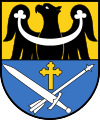Legnickie Pole
| Legnickie Pole | |||
|---|---|---|---|
| Village | |||
|
St. Hedwig's church | |||
| |||
 Legnickie Pole | |||
| Coordinates: 51°09′N 16°15′E / 51.150°N 16.250°E | |||
| Country |
| ||
| Voivodeship | Lower Silesian | ||
| County | Legnica County | ||
| Gmina | Legnickie Pole | ||
| Population | 780 | ||
Legnickie Pole [lɛɡˈnit͡skʲɛ ˈpɔlɛ] (in 1945-1948 Dobre Pole, German: Wahlstatt) is a village in Legnica County, Lower Silesian Voivodeship, in south-western Poland. It is the seat of the administrative district (gmina) called Gmina Legnickie Pole.
It lies approximately 10 kilometres (6 mi) southeast of Legnica, and 56 kilometres (35 mi) west of the regional capital Wrocław. The village has a population of 780.
History
The village was the site of the decisive Battle of Legnica (Battle of Liegnitz) on 9 April 1241. In the battle, Mongols of the Golden Horde led by Kadan and Baidar defeated a Polish-German army under Duke Henry II the Pious of Silesia. The Mongols annihilated their opponents and joined with the main army in Hungary, but upon receiving the news of the death of their Grand Khan Ögedei Khan, they turned back to attend to the election of a new Khagan, or Grand Khan. The battle marked the westernmost expansion of the Mongols into central Europe. From 1335 until 1742 it was part of the Kingdom of Bohemia and thus later of Austria.
The village became part of the Kingdom of Prussia during the 18th century Silesian Wars in 1742. During the Napoleonic Wars, the Prussian general Prince Blücher defeated a French army under Marshal MacDonald at the Katzbach, a small river running through Wahlstatt and Liegnitz, in the Battle of Katzbach on 26 August 1813. In honor of this victory Blücher received the title Prince of Wahlstatt on 3 June 1814.
The village became part of People's Republic of Poland following World War II, had its German-speaking population expelled, and was given its current Polish name Legnickie Pole ("Field of Legnica", from 1945-48 it was named Dobre Pole [Good Field]).
In the old village church (in front of the St. Hedwig's) is the museum of the battle of Legnickie Pole.
Saint Hedwig Church
A Baroque abbey built at Wahlstatt in 1727 through 1733 with its complex of attendant buildings became a Prussian training institute for cadets in 1840. Among others, future field marshal and German president Paul von Hindenburg studied here from 1859 to 1863, as did the Red Baron, Manfred von Richthofen, until 1911.
Following the Treaty of Versailles, which limited the size of the German military, the abbey was turned into a boarding school for boys in 1920. During the Nazi era, it was first a National Political Institute of Education and in the final months of the war a prisoner of war camp Oflag VIII-F.
The former abbey became a hospital for emotionally disturbed women in 1957. The Baroque church now houses a museum of the Battle of Legnica. The abbey is one of Poland's official national Historic Monuments (Pomnik historii), as designated May 1, 2004, and tracked by the National Heritage Board of Poland.
External links
- Official website (Polish)
- Gmina website (Polish)
| Wikimedia Commons has media related to Legnickie Pole. |
Coordinates: 51°09′N 16°15′E / 51.150°N 16.250°E

